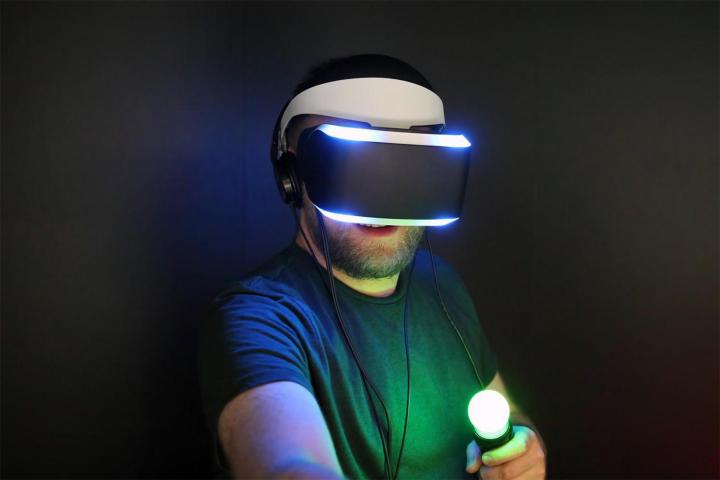
Sony chose fertile soil to plant the seeds for its virtual reality debut, Project Morpheus. The 2014 Game Developer’s Conference isn’t exactly an E3 marketing machine sort of environment, but the freshly announced PlayStation 4-friendly headset isn’t exactly ready for consumers to chomp down on either. What it is ready for is content, and fresh approaches to creating that content. Suddenly it makes a whole lot of sense that the company chose to trot its nifty VR headpiece out in front of an army of developers.
We snagged a heads-on peek at what’s going on inside of Morpheus and the good news is, it’s close to where the Oculus Rift is right now. Sony’s first crack at virtual reality is nearly on the level with the top contender in that space, with head tracking, motion tracking (compliments of the PS4 camera), and 1080p resolution split between your two eyes (for a resolution of 960×1080 per eye). It’s a stylish piece of tech too, even in prototype form, with rounded edges and a black strip across the front with white strips backlit by blue LEDs above and below it.
Sony offered up three different demos at its GDC booth to showcase the capabilities of Morpheus in its current form. The first, called The Deep, is a relatively non-interactive piece in which your scuba diver descends into the ocean depths from inside a sharkproof cage. That sharkproofiness is put to the test when a stream of blood from a small cut attracts one of the undersea killers.

You remain stationary inside the cage for the length of the demo while the shark circles and, eventually, forces its way in. Still, The Deep effectively highlights a few elements that make Morpheus compelling. Although you never leave the cage, you do clutch a DualShock 4 gamepad in one hand throughout the demo, with the controller doubling as a flare gun in the virtual space. The combination of the DualShock and a PS4 Eye camera allows for the game to register and track 1:1 movements of whichever hand you’re clutching the controller in. It’s precise enough to know when you rotate your wrist. The camera also reads your body to a limited extent; bend your knees in the real world while you’re looking down at your diver’s body, and you’ll see those virtual knees bend as well. That’s not something we’ve seen yet from Oculus.
The second demo, referred to only as Castle, is a bit more elaborate. This one does away with the DualShock, instead putting one PS Move control wand in each hand. The motion sensing devices double as your in-game hands, and you can use each one’s trigger buttons to grab items or clench hands into a fists. Inside the headset, you view the world from the perspective of a knight standing in a castle courtyard. The demo cycles through a series of training exercises as you take on an armored dummy with your fists, swords, and a crossbow.
Bend your knees in the real world while you’re looking down at your diver’s body, and you’ll see those virtual knees bend as well.
Castle also includes a section that involves shooting a crossbow at targets (along with that poor, abused dummy), which is an unusual experience at first. In most shooters, you’d simply press and hold a trigger button to aim down your equipped weapon’s sights. In VR, however, the most natural thing to do when looking down the sights of the crossbow is to close one eye and bring the weapon relatively close to your face, just as you would in a proper physical space with an actual ranged weapon.
The final playable portion of the demo turned out to be a sitdown with the latest iteration of CCP Games’ EVE: Valkyrie, the space dogfighting sim that’s been the subject of much discussion and excitement since its 2013 reveal. The game looks and feels more polished than ever, with sharper graphics, a sleeker in-cockpit design, and – most importantly – a more fleshed out experience. The ships you’re shooting at are now durable enough to withstand more than one missile strike from the head tracking-powered lock-on missiles. This means you’ve got to fly more skillfully if you want to score kills, which serves as a stronger hook for immersing you in the virtual space.

The experience of using Morpheus is similar in many ways to how Oculus Rift feels in its present, post-Crystal Cove state. The LCD screens might even be a wee bit sharper than the Rift’s, though you get noticeably more motion blur when the Sony device is strapped to your head. The Morpheus fits onto your head using two straps that allow you to adjust the fit around back and release tab beneath the front-mounted eyepiece that allows you to tweak the distance between your eyes and the twin displays (presumably to better accommodate glasses wearers).
Sony’s got a ways to go with Morpheus, but the army of developers that were on hand for its unveiling should help to prepare a flow of content for its eventual release. Let’s just hope that the consumer model still makes you look like an extra in Daft Punk.


